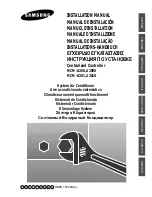
89
Refrigerant Piping System Installation for Heat Recovery Operation
Due to our policy of continuous product innovation, some specifications may change without notification.
©LG Electronics U.S.A., Inc., Englewood Cliffs, NJ. All rights reserved. “LG” is a registered trademark of LG Corp.
INSTALLING FOR HEAT RECOVERY
OPERATION
Service Ports
Heat Recovery Outdoor Unit Service Port Detail
Heat Recovery Outdoor Unit
Service Port Diagram.
1. Liquid piping service port (back seated type with
right hand thread).
2. Low pressure vapor piping service port (back
seated type with right hand thread).
3. High pressure vapor piping service port (back
seated type with right hand thread).
4. Stem head access with factory-provided cap.
5. Schrader ports with factory-provided cap.
6.
Service port piping to connect to field piping.
Opening and Closing the Schrader Ports
1. Loosen the Schrader port caps on the liquid, low pressure vapor, and high pressure vapor service ports.
2. After the leak / pressure, triple evacuation, and trim charge procedures are complete, securely tighten all Schrader port caps.
Do not apply excessive force to the Schrader and service ports.
Opening the Service Port
1. After servicing is finished and the system is ready for operation, remove the stem head access caps
on the liquid, low pressure vapor, and high pressure vapor piping service ports.
2. Turn the valve stem counterclockwise using a metric sized Allen wrench (4mm to 8mm, depending on
the size of the port).
3. Turn until the valve stem is out, stops, and the valve is completely backseated. Do not apply
excessive force.
4. Securely replace the stem head access caps.
Operating the Service Port Components
Closing the Service Ports
1. If present, remove the stem head access caps on the liquid, low pressure vapor, and high pressure
vapor piping service ports.
2. Turn the valve stems clockwise using a metric sized Allen wrench (4mm to 8mm, depending on the
size of the port).
3. Securely tighten the valves until the shaft contact the main body seal. Do not apply excessive force.
4. Securely replace the stem head access caps.
Opening the Service Ports.
1
2
3
5
6
4
5
Do not expose the outdoor unit service valves to heat. Protect the service valve with a wet towel during brazing.
• Before connecting the refrigerant piping, make sure the service port valves of the outdoor unit are completely closed (factory setting).
Do not open the service port valves or attempt to operate the system until the refrigerant pipe system installation has been completed. Never
open the valves before a pressure test is performed, a leak test performed, the system is evacuated, and the Commissioning Agent provides autho-
rization to do so.
Do not use polyolester (POE) or any other type of mineral oil as a thread lubricant. If introduced to the refrigerant circuit, it will
create oil sludge leading to system malfunction. Use PVE (polyvinyl ether) type refrigeration oil only.
• Protect the liquid and vapor piping / ports with a wet towel during brazing.
• Use a 15% silver phosphorous copper brazing alloy to avoid overheating and produce good flow.
Do not use flux, soft solder, or anti-oxidant
agents. If the proper material is not used, oxidized film may accumulate and clog or damage the compressors. Flux can harm the copper piping or
refrigerant oil.
• When brazing the field-supplied refrigerant piping to the outdoor unit connections, flow 3 psig nitrogen into the piping. If nitrogen was not flowed
during brazing, the piping may oxidize and cause membranes to form, which may negatively impact valve and condenser operation.
• Outdoor units ship with a factory charge of refrigerant. Always take extreme caution to prevent refrigerant gas (R410A) from leaking during use,
around fire or flame, and during brazing. If the refrigerant gas comes in contact with a flame from any source, it may break down and generate a
poisonous gas.
Do not braze in a small room, or a room that is not ventilated.
• After refrigerant piping work is complete, verify that the Schrader port and service port caps are securely tightened to help prevent refrigerant gas
from leaking. Verify the system is free of leaks after refrigerant piping installation is complete. Exposure to high concentration levels of refrigerant
gas may lead to illness or death.
•
Do not attempt to remove the service valve stem. Physical injury or death may occur from the uncontrolled rapid release of refrigerant.
















































